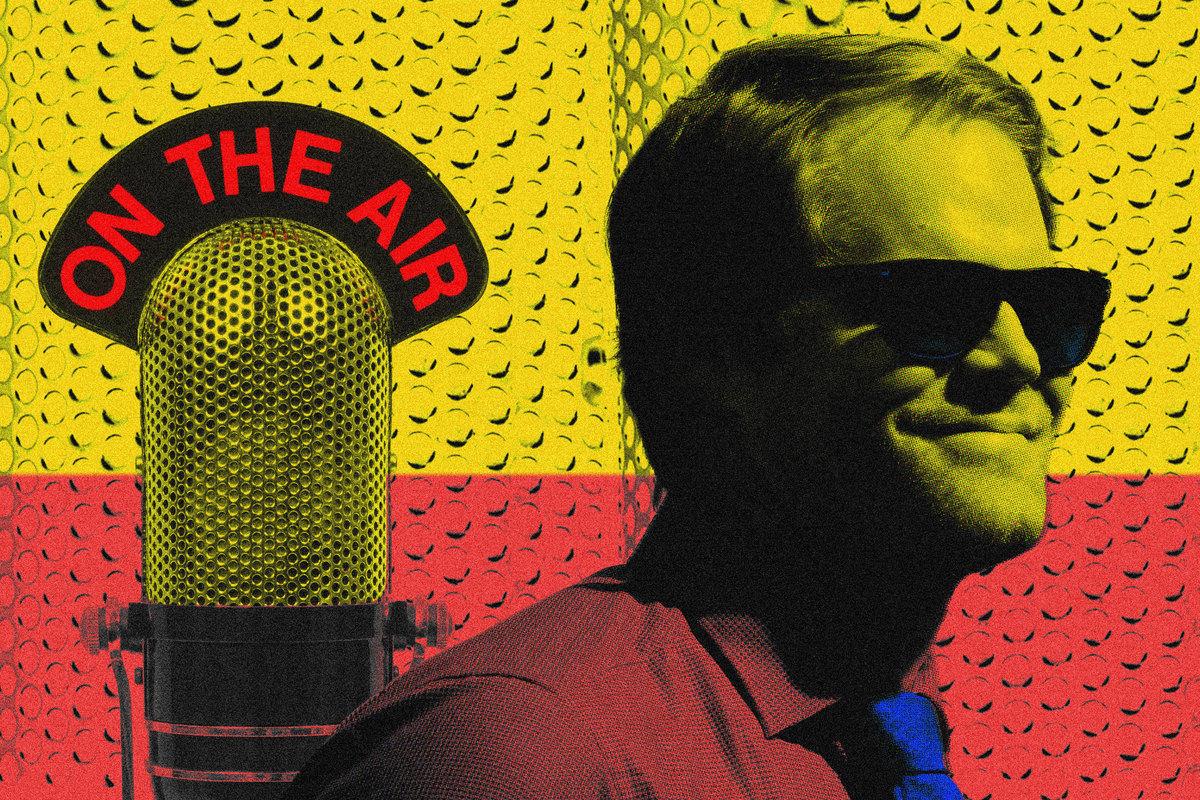
In his single season on Fox’s first-string announcing team, Greg Olsen did something amazing. He made the first convincing case in two decades for benching Tom Brady. Brady and his $375 million contract with Fox will likely take Olsen’s job after Olsen calls the Super Bowl. Olsen proved that wouldn’t be a quality judgment.
Olsen calls games with the energy of a guy who gave up handshakes during the COVID-19 pandemic but made up for it with twice the fist bumps. He can recognize subtle bits of in-game strategy. He understands the new calculus of going for it on fourth down. Praise hasn’t given him a big head (at least metaphorically speaking). Olsen has shown you can honor football’s intricacies while gently mocking the serious business of crushing tape. “RPO, you hear that’s kind of a buzzword,” he said on the air this year. “Everyone at home takes a drink.”
NFL Twitter has embraced Olsen as “one of us.” But I think a lot of people missed a key part of his rise. When the season started, Olsen wasn’t this good at announcing. He got this good by fixing a hole in his game. Just about everyone who talks football into a microphone for a living could learn from his example.
Fox identified Olsen as a potential announcer nearly five years ago, like a TV version of a draft-and-follow prospect. In 2017, when Olsen was still playing tight end for the Panthers, Fox hired him to call a game during his bye week. Two years later, the network stuck him on its studio shows during the playoffs. When Olsen announced his retirement from football at the end of the 2020 season, he did it on Fox NFL Sunday.
2020 was a momentous year in the football announcing business. Tony Romo signed a deal worth $17 million per year to stay at CBS that February. Inside Fox, executives took one big lesson from that deal, I heard at the time. They wanted to develop a no. 2 announcer so that they wouldn’t get held for ransom.
Olsen, who joined Fox’s no. 2 team with Kevin Burkhardt the following season, turned out to be the perfect broadcasting insurance policy. Last spring, when Troy Aikman left Fox for ESPN, Olsen and Burkhardt were ready to step in with the no. 1 team. He could have handled the job for years if Brady had decided to play for the Raiders. Olsen could slide back into it if Brady decides TV isn’t his lifelong calling.
Olsen arrived at Fox as a very toolsy young announcer. Watching him call a Cowboys-Panthers game a year ago, I was struck by how well he understood how to get in and out of the 10-second windows that follow each play. I wouldn’t call Olsen a wordsmith, but he has a big lug’s way of stumbling into profundity. “Soft-tissue stuff is hard,” he said during a game in October. Unlike Drew Brees, another rookie in the broadcasting class of 2021, Olsen had tons of things he wanted to say.
But when this season began, Olsen was still very green. Take his first outing with Fox’s no. 1 team, a Cardinals-Ravens preseason game in August. After an ad break, a replay was cued up so that Olsen could explain why Arizona quarterback Trace McSorley missed an open running back on fourth down. Check this out:
You can see Jonathan Ward in the backfield. He’s just running what they call a running back shoot route. You can see he gives McSorley his eyes right there. Put it on him. This is the alert, Kev, where if they want to pass off that coverage to the front side, into the boundary—meaning the closest sideline to where you’re lined up—that ball needs to be put on Ward’s chest. He gets a great run after catch. He’s clearly going to get the first down. McSorley kind of starts, and then he gets flushed because his eyes start away. And then the timing, he tries to force it to [tight end Trey] McBride. So, sometimes, with young quarterbacks, they’re not sure exactly where to start with their eyes. There was some different disguising going on.
See what happened? Olsen was saying McSorley should have thrown the ball to Ward. But he wound up burying a simple point under a termite mound of details and buzzwords: a shoot route, the defense passing off receivers, the quarterback and the running back’s eyes, and the definition of “boundary.” Everyone at home takes a drink!
Early in the season, words were tumbling out of Olsen’s mouth like this. “I’m the first to admit, sometimes you’re so excited. You’re so anxious for the game to start,” Olsen told me last month. “You have so many great thoughts, … and it’s like you don’t need to get them all out in the first drive.”
Olsen was the anti-Brees: He had too much to say. When Olsen’s brain started whirring, Richie Zyontz, his producer, would say into his earpiece, “Remember to slow down.” Olsen joked that the game didn’t start until he heard that mantra.
The hole that was in Olsen’s game is a very, very common one. In an age when it’s possible to know more than we ever have about pro football, we all have too much to say.
Listen to just about any NFL podcast. When tossed a simple question about, say, the Chiefs defense, a host won’t offer one answer. The host will offer five answers, joined together in a monologue, each informed by film study and advanced stats. I love this new, wised-up universe. It’s way better than the grunting ’90s. But when you mesmerize an audience with too much detail, the audience probably won’t remember any of it.
TV has faced its own version of the too-much-information problem. More than a decade ago, NBC’s Cris Collinsworth realized fans who were reading Bill Barnwell’s and Aaron Schatz’s columns were ready to hear game announcers talk about the sport in more detail. Collinsworth began talking about schemes in more complexity on Sunday Night Football, and data from his own Pro Football Focus popped up on the screen. The challenge for Collinsworth and fellow travelers like Olsen and ESPN’s Dan Orlovsky is how much of this information helps the audience understand what happened and how much is just … more information.
“In the beginning, I wanted to point out what everybody was doing,” Olsen told me. “Because I thought it was always so fascinating.” One reason NFL Twitter loves Olsen is that he talks about football like they do.
This season, Olsen realized he had to perform radical surgery on his announcing. He wanted to cut down those five fascinating observations to one or two memorable ones. Olsen described the coaching he got from Zyontz like this: “You don’t have to say everything you see on every play. Even though it might all be interesting, and even though it all might be a big part of the play, you have another three hours of the broadcast to get it in. So pick the most important thing.”
A few weeks into the regular season, you could see Olsen fixing the hole in his game. By the playoffs, he’d gotten even more focused. Take the interception Dak Prescott threw in the second quarter of the Cowboys-49ers divisional game. Here’s how Olsen explained it:
We said earlier, Kev, how important Jimmie Ward, the nickel cornerback, how important he’s gonna be because of the work in the slot by CeeDee Lamb. He’s just playing nickel zone. It’s Cover 2. And his eyes are just on Dak Prescott. Dak never sees him. Dak actually throws the ball off of Jimmie Ward’s chest and it bounced into Fred Warner’s hands. He’s just reading his eyes and he comes in and just poaches from his nickel corner spot, that outbreaking route by CeeDee Lamb…
Olsen still mentioned concepts like nickel zone. But they were adornments to the point he was making about the interception rather than the substance. The point was how Ward ate Prescott’s lunch.
The next week, in the NFC championship game, Eagles running back Miles Sanders scored on a run late in the first half. On the replay, Olsen noted that center Jason Kelce lumbered so skillfully in space that Kelce made it impossible for Dre Greenlaw, the 49ers linebacker, to redirect the play inside. Olsen left it at that. When the Eagles nearly iced the game with a touchdown run a few plays later, Olsen again said one thing: Defensive end Nick Bosa had failed to set the edge.
For Olsen, a self-edit didn’t mean transforming into Phil “the game was won in the trenches” Simms. Olsen is the same guy bursting with ideas. He’s just a better broadcaster. Now, Fox finds itself in an odd place. Its post-Romo strategy worked just as it intended. But Fox is under the thumb of a market-setting contract with Brady that it willingly signed. The ransom demand is coming from inside the network.
We tend to think of announcers as NBA trade deadline–style assets. (Note how every story about Olsen having a good year jumps immediately to the question of whether he’ll leave Fox if he gets passed up by Brady.) Or else we think of announcers as having a level of skill that never fluctuates unless they get older.
Announcers can change. Romo got lazier and sloppier. Olsen got crisper and more focused. Nowadays, if Olsen doesn’t hear Zyontz whispering his mantra early in a game, he’ll tell his producer: “Come on … come on …”
“You haven’t talked that fast yet,” Zyontz will reply. “I’m saving it.”


